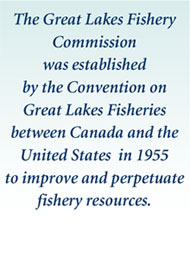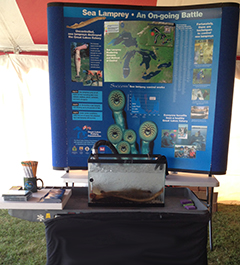

GLFC Celebrates Passage of the Great Lakes Fishery Research Reauthorization Act.

USGS scientist takes aim at Great Lakes invaders
Rising Higher: A Research Lab Built from the Ground Up - Part 2
Great Lakes Researchers Go Down Under
Rising Higher: A Research Lab Built from the Ground Up - Part 1
A Monograph on Ciscoes of the Laurentian Great Lakes and Lake Nipigon
WATCH: Acoustic Telemetry Provides In-Depth Look into Fish Behavior
Eel-Ladder Style Traps: A New Lamprey Control Tool
A Lampricide Treatment: Up-Close
Lamprey Nativeness Claims Annulled by Commission's Eshenroder
A Population at the Edge: American Eel Declining at the Extremes
Celebrating 60 Years of Successful Sea Lamprey Control, Science, and Cross-Border Collaboration!
Great Lakes Scientists Use Acoustic Telemetry to Reveal the Secret Lives of Fish
Hammond Bay Biological Station: The Nexus for Research and Restoration on the Great Lakes
Big Consequences of Small Invaders
New Sea Lamprey Estimates Suggest a Dramatically Decreased Population
Conducting Research through Cooperative Partnerships: The PERM Agreement
Living on the Edge: A Closer Look at Coastal Communities
Asian Carp: The War Isn't Over
Managing the Lake Huron Fishery
Understanding Sea Lamprey: Mapping the Genome and Identifying Pheromones

Taking Lampreys on the Road!
If you have made it to this webpage, you may already be familiar with the sea lamprey, a parasitic "vampire" fish that invaded the Great Lakes through shipping canals in the early 1900s. The sea lamprey - using its tooth-filled mouth - rasps holes into fish and drinks their blood and fluids. Each sea lamprey destroys up to 40 pounds of fish in 12-18 months. As they spread throughout the Great Lakes, they devastated the region's commercial and recreational fisheries.
We often hear: "Sea lampreys? I thought that problem was solved decades ago." In one respect, that's true - sea lamprey populations are a small fraction of their peak in the 1950s before the Great Lakes Fishery Commission began its successful control program. It's not surprising then, that many people are not aware that sea lampreys are still a problem in the Great Lakes. The commission takes that as a compliment - it means we are doing our job. Nevertheless, sea lampreys are resilient beasts and left uncontrolled, even briefly, they bounce back with a vengeance.
So, the sea lamprey invasion story is an important one to tell as it is cautionary about preventing invasive species from entering the lakes in the first place, and it highlights the importance of on-going control. Indeed, the sea lamprey control program is one of the most successful invasive species programs in the world and is absolutely essential for the protection of the Great Lakes. $7 billion fishery.
How do we remind people of this old, on-going problem? We take our story (and live sea lampreys) on the road!
One of the goals of the commission's communication program is to perform outreach to provide members of the public the opportunity to learn about (and see) sea lampreys, interact with sea lamprey control program staff and advisors, and take home information to help share their newfound knowledge.
In the last several decades, the commission has attended scores of events throughout the Great Lakes basin to talk directly with people of all ages and from a variety of communities - not just anglers - about sea lampreys and the successful control program.
The commission's booth is a big hit because it includes a tank of live sea lampreys. Visitors can view the vampire-like mouth sticking to the aquarium glass and their slimy snake-like bodies! The booth also includes information about how sea lampreys are controlled, along with a few take-home items such as brochures and fact sheets, DVDs, pencils, and the very popular sea lamprey tattoo!
The most commonly asked questions and comments that we hear when staffing the outreach display, besides the high-pitched, "Ewww! What are those things?!?" include:
- "Do they attack people?"
- "I haven't heard anything in the news about sea lampreys in recent years, so I figured they were not a problem anymore."
- "I don't want that to touch me!"
- "Those aren't in Lake _______, are they?"
- "Can you eat them?"
- "What's being done to control sea lamprey populations?"
- "Can I hold one?"
The frequency of these questions reiterates the importance of performing outreach. At each event, commission and partner agency staff talk to hundreds (sometimes thousands) of people about sea lampreys and the damage that invasive species inflicted on the Great Lakes fishery. The commission's sea lamprey control program, too, greatly benefits from this interaction with the public. To successfully implement sea lamprey control, the commission must rely on a variety of people, from landowners, to fishermen, to current and future generations of voters. Therefore, ensuring that residents of the Great Lakes Basin are aware of the on-going sea lamprey battle is critical to developing and maintaining support for this crucial program.
If you live within the Great Lakes Basin, be on the lookout for a commission sea lamprey booth at a sporting or boating event near you! Between January and August of 2014, the commission display will be at the following events:
- Mid-America Boat & Fishing Show: Cleveland, OH, January 16-20
- Chicago Outdoor Sports Show: Chicago, IL, January 22-26
- Toronto Sportsmen's Show: Toronto, ON, February 6-9
- Duluth Boat, Sports, Travel, and RV Show: Duluth, MN, February 12-16
- Central Canada Outdoor Show: Thunder Bay, ON, February 21-23
- Northeast Wisconsin Sport Fishin' Show: Appleton, WI, February 28-March 2
- Belle Isle Aquarium Event: Detroit, MI, March 1
- Spring Outdoor Days and Captain's Weekend: Cabela's in Hammond, IN, March 1-2
- Niagara Sportsmen Show: Niagara, ON, March 14-16
- Ultimate Sports Show: Grand Rapids, MI, March 20-23
- 2nd Annual Northern Michigan Sports Expo: Cheboygan, MI, May 16-18
- La Porte County Fair: La Porte, IN, July 6-12
- UP State Fair: Escanaba, MI, August 11-17
Additionally, there are two long-term exhibits in the region that specifically discuss and display live sea lampreys. The newly-renovated "At Home on the Great Lakes" exhibit at the John G. Shedd Aquarium in Chicago, IL, and the "Aquatic Invaders" exhibit at the Great Lakes Aquarium in Duluth, MN, are well worth a visit if you are in the area.
All of the commission's outreach materials are free to the public. Most materials are accessible on the commission's website [www.sealamprey.org]. Predator in Paradise, a 20-minute video about the damage inflicted by sea lampreys and the highly successful control program is available on the commission's YouTube channel [www.youtube.com/lampreycontrol]. If you are unable to attend an outreach event but are still interested in acquiring some of these materials, please contact Ted Lawrence, Communications and Policy Associate, at ted@glfc.org or 734-669-3008.


The commission has two sizes of displays to accommodate different venues. Both contain information about the sea lamprey control program and contain a tank of live sea lampreys. PHOTOS: J. Wingfield, GLFC (top) and A. Miehls, GLFC/USGS (bottom)


The sea lamprey booth - especially the tank of live sea lampreys - attracts, entertains and educates kids of various ages. The commission has temporary tattoos of the sea lamprey mouth that are always a big hit! PHOTOS: A. Miehls, GLFC/USGS


